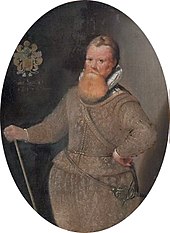Frederick de Houtman
Frederick de Houtman (other common spelling: Frederik) (b. 1571; † 1627) was a Dutch navigator, explorer and administrator. He compiled the oldest surviving star catalogue of the southern sky (1603) and sailed along the west coast of Australia (1619).
Frederick de Houtman was born in Gouda; in 1590 he lived in Alkmaar, where he married. In 1594 Frederik and his brother Cornelis de Houtman were captured in Lisbon. Nevertheless, they brought back 25 sea charts, drawn by Bartolomeo de Lasso.
From April 1595 to August 1597 he took part in the first Dutch East India expedition under the command of his elder brother Cornelis. They had the Itinerario of Jan Huygen van Linschoten and landed in September on the southwest coast of Madagascar, where 70 men had to be buried because of illness and vitamin C deficiency. In February they sailed on. By June the four ships were in Bantam. Up to this point, Houtman assisted navigator Pieter Dirkszoon Keyser in compiling a star catalogue.
At the time, it was believed that compass needles showed deviations the further south one went. Plancius instructed Frederick de Houtman in astronomical positioning to verify the phenomenon. He asked the navigator Pieter Keyser to make celestial observations and map the southern starry sky and equipped him with a device (probably an astrolabe).
In November, they continued on to Java's coast. When one of the captains was poisoned, the crew did not want to continue. They landed in Bali and returned in February. When three ships arrived on Texel in August instead of four, only a third were still alive. There are several descriptions of this voyage.
The first Dutch East India expedition from April 1595 to August 1597 was disastrous and a commercial failure. Of 249 participants, only 87 returned alive, the majority having died as a result of disease and violence. Moreover, only a few barrels of pepper could be acquired. However, the venture can be seen as the beginning of Dutch colonial rule in East Asia. It also broke Portugal's monopoly on the spice trade.
Keyser and Houtman had successfully surveyed the southern sky and made maps (Keyser had died on the voyage), introducing twelve new constellations. Plancius first placed them on a celestial globe in 1597/1598, published by Jodocus Hondius in 1600, and on globes by Willem Blaeu in 1602 and 1603. Johann Bayer adopted them in his celestial atlas Uranometria published in 1603.
During a second expedition under Laurens Bicker, which started in 1598, Cornelis de Houtman was killed and Frederick became a prisoner of the Sultan of Aceh in the north of the island of Sumatra for 26 months. He used this time to study the Malay language and made celestial observations. Keyser's catalogue he expanded to 304 stars. However, 107 of them are already mentioned in Ptolemy's Almagest. De Houtman refused to become a Muslim. When he showed that he could build a mill, he was released.
In 1603 Houtman returned to the Netherlands. Curiously, he published his astronomical observations as an appendix to a dictionary for the Malay and Malagasy languages. Based on Noël de Barlaimont, he wrote 12 dialogues and added 1,000 words from Turkish and Arabic. The cartographer Willem Janszoon Blaeu used Houtman's catalogue in the creation of his celestial globes. Only a few copies of the catalogue exist today, one of which is in the library of Oxford University. Keyser's catalogue, on the other hand, is lost.
Between 1605 and 1611 Frederick de Houtman was governor of the Netherlands on the island of Ambon. De Houtman translated the Lord's Prayer, the Ten Commandments and the Heidelberg Catechism into Malay. In 1619, during another expedition, De Houtman came to the Australian coast near present-day Perth. Following the coast northward, he came upon a group of small coral reefs and shoals, now the Houtman-Abrolhos Archipelago. In 1621 he became governor of the Moluccas.

Frederick de Houtman
Search within the encyclopedia